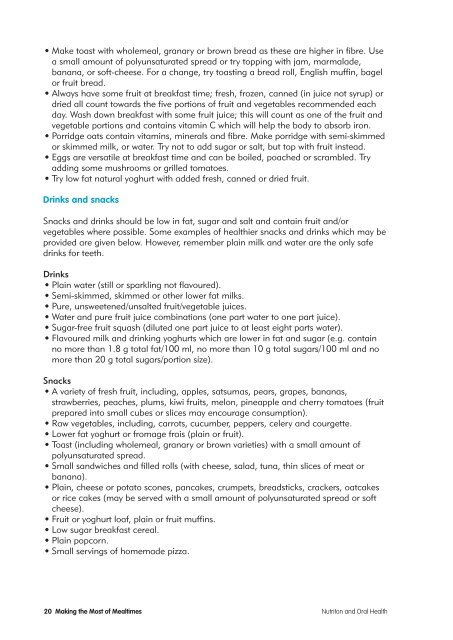Nutrition and Oral Health - Strategy into Practice ... - NHS Lanarkshire
Nutrition and Oral Health - Strategy into Practice ... - NHS Lanarkshire
Nutrition and Oral Health - Strategy into Practice ... - NHS Lanarkshire
- No tags were found...
You also want an ePaper? Increase the reach of your titles
YUMPU automatically turns print PDFs into web optimized ePapers that Google loves.
• Make toast with wholemeal, granary or brown bread as these are higher in fibre. Usea small amount of polyunsaturated spread or try topping with jam, marmalade,banana, or soft-cheese. For a change, try toasting a bread roll, English muffin, bagelor fruit bread.• Always have some fruit at breakfast time; fresh, frozen, canned (in juice not syrup) ordried all count towards the five portions of fruit <strong>and</strong> vegetables recommended eachday. Wash down breakfast with some fruit juice; this will count as one of the fruit <strong>and</strong>vegetable portions <strong>and</strong> contains vitamin C which will help the body to absorb iron.• Porridge oats contain vitamins, minerals <strong>and</strong> fibre. Make porridge with semi-skimmedor skimmed milk, or water. Try not to add sugar or salt, but top with fruit instead.• Eggs are versatile at breakfast time <strong>and</strong> can be boiled, poached or scrambled. Tryadding some mushrooms or grilled tomatoes.• Try low fat natural yoghurt with added fresh, canned or dried fruit.Drinks <strong>and</strong> snacksSnacks <strong>and</strong> drinks should be low in fat, sugar <strong>and</strong> salt <strong>and</strong> contain fruit <strong>and</strong>/orvegetables where possible. Some examples of healthier snacks <strong>and</strong> drinks which may beprovided are given below. However, remember plain milk <strong>and</strong> water are the only safedrinks for teeth.Drinks• Plain water (still or sparkling not flavoured).• Semi-skimmed, skimmed or other lower fat milks.• Pure, unsweetened/unsalted fruit/vegetable juices.• Water <strong>and</strong> pure fruit juice combinations (one part water to one part juice).• Sugar-free fruit squash (diluted one part juice to at least eight parts water).• Flavoured milk <strong>and</strong> drinking yoghurts which are lower in fat <strong>and</strong> sugar (e.g. containno more than 1.8 g total fat/100 ml, no more than 10 g total sugars/100 ml <strong>and</strong> nomore than 20 g total sugars/portion size).Snacks• A variety of fresh fruit, including, apples, satsumas, pears, grapes, bananas,strawberries, peaches, plums, kiwi fruits, melon, pineapple <strong>and</strong> cherry tomatoes (fruitprepared <strong>into</strong> small cubes or slices may encourage consumption).• Raw vegetables, including, carrots, cucumber, peppers, celery <strong>and</strong> courgette.• Lower fat yoghurt or fromage frais (plain or fruit).• Toast (including wholemeal, granary or brown varieties) with a small amount ofpolyunsaturated spread.• Small s<strong>and</strong>wiches <strong>and</strong> filled rolls (with cheese, salad, tuna, thin slices of meat orbanana).• Plain, cheese or potato scones, pancakes, crumpets, breadsticks, crackers, oatcakesor rice cakes (may be served with a small amount of polyunsaturated spread or softcheese).• Fruit or yoghurt loaf, plain or fruit muffins.• Low sugar breakfast cereal.• Plain popcorn.• Small servings of homemade pizza.20 Making the Most of Mealtimes Nutriton <strong>and</strong> <strong>Oral</strong> <strong>Health</strong>
















